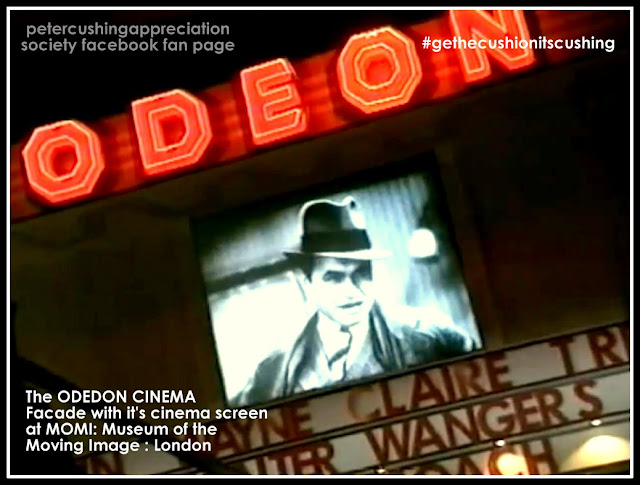#GETTHECUSHIONITSCUSHING : One day, in another life, wearing another hat, I was in London, on the Thames embankment, yes the one where we see Cushing's Van Helsing pause for taking a breath in Dracula AD 1972. I was taking a large group of my students, on a field trip visit to MOMI, the Museum of the Moving Image. This was my first trip there. But, I had been told by many others, that it would be very worth-while and full of useful resources to film students. PLUS, some close friends who knew me and my hobbies very well, hinted that somewhere inside, was a little 'something', that I would really appreciate! How could resist? After getting 30 students through the box office, producing mutiple-prebooked tickets, each student was dispatched with worksheets and tasks, to keep the 'little darlings' busy for the best part of an afternoon, leaving me free to wander my way through the exhibits, interactions and displays. It was a vast building, and the museum was split into each 'Cinema Through A Decade' at a time. You walked into each decade area, through the door of a facade of a cinema of that era. In the early 1900's exhibit, you entered through a large opening in a tent, that represented, the traveling cinemas of the time.
I MADE MY WAY INTO the early 'glasshouse studios' of France, and the hand cranked cameras of the 1920's, until I walked through the box office and frontage of a London cinema of the 1930's. After twenty minutes, I came upon the 'something' my friends, had hinted about. Inside a glass case, was the actual Boris Karloff, lighting double dummy. Now looking a little tatty, but the genuine article. It was an impressive thing to see. I thought about my friends, and how they would have come upon it, when they visited, and how they probably all gave each other 'the nod', and chorused, 'Wow, you know who would like this! Ha!'. And, I did. It was certainly worth the price of the admission alone. I stood looking at it, for about twenty minutes, and made my way through the 1940's section. It was then I heard music in the distance. Faintly, just above the clashing voices, narrations and music from the other exhibits. It was a snare drum, and strings... 'diddle, diddle, dum. Diddle, diddle dum, ..dum..dum, dum, dum, dum, dum, DAH, DAH...! I knew that rhythm! But, it couldn't be? I turned on my heals and rushed across the hallway, towards a corner ahead, around where, I thought that music was coming from. I turned the corner, and stopped in my tracks! Before me, I saw the huge facade of an Odeon 1950's cinema building, and outside the doors stood a very smart conseiage, above him and above the huge ODEON sign, a cinema screen, and on it . . . .
THE LAST THREE MINUTES OF HAMMER FILMS 1959, DRACULA! At that time, like many, I had seen the scene unfold hundreds of times on my TV, but NEVER had I seen it, on a cinema screen! I stood, peering up at the screen. Cushing running down the large refractory table, jumping at the curtains, Christopher Lee's scream and gasp of horror..and my gulp of emotion. I am not ashamed to admit it, I was profoundly moved. For me, it's probably the most iconic of all the scenes, from any and all the Hammer films. As a ten year old, I listened to it's soundtrack, on my battered reel to reel tape recorder, which was given to me by my uncle, because I wouldn't let up nagging him, until he gave it to me! Then, I transferred that recording onto an audio cassette. This was before the age of video, so a selection of images from the scene in a US magazine, would be poured over, while listening to the cassette! Then, VHS.
DRACULA'S TUMBLE-WEED OF DEAD HAIR, drifted across the marble floor, as I looked to my right and left, I was surprised to see, a small crowd had gathered around me, all quietly watching the scene too. The titles were now moving up the screen. I sighed, and still looking up at the screen, took two steps back, before turning and almost colliding with a tall, thin face man, who had also been watching the scene up there too. 'Good, wasn't it?' he said smiling. Startled, I stepped back, catching my balance, I looked up one more time at the screen. 'Yes!' I said. 'It was VERY good' I watched the picture fade to black. 'Are you are a fan? A fan of.. Peter Cushing?' I turned to catch his answer. But he was gone!
'Van Helsing pursues Dracula through the castle, accompanied by James Bernard's insistent chase theme. Dracula catches Van Helsing and tries to throttle him, Van Helsing tricks Dracula by playing dead. Then, in the nick of time, he leaps up. The vampire and the vampire hunter stand off like tigers. Then Van Helsing makes his final move. . . .
'As Dracula decays, Van Helsing's haunted expression conveys a mixture of exhaustion, revulsion, sadness and relief. Cushing later explained his own feelings about that shot : 'I was reading a review of the film, from a critic who said, '...at the end of Dracula, there is a look of sadness on Van Helsing's face. He has suddenly achieved his life's quest, and now what is he going to do? I can tell you that I didn't have that in my mind at all, when we were shooting the film. I stood there and run my hand through my hair and look down out of exhaustion. But the critic was absolutely right. Something in me was communicating that to the audience, and the audience fills in the rest!'













































